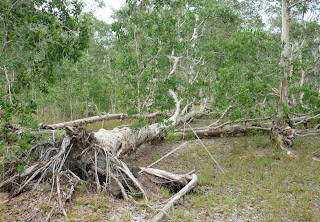Firstly there was this beach. I know there is no such thing as a never ending beach, but must be close!
Just inland were these huge metal parts that seem to have been left behind. Looks like a winching system of some sort, so maybe it was for loading boats or something similar.
The area is covered in paperbarks and there were large areas like this where all the trees seemed to be almost the same size. My guess is that this is post Tsunami regeneration. In amongst them there were just a few much larger trees I am supposing were the few survivors. Throughout this area there were no epiphytic plants, again suggesting regeneration.
Some areas seemed to be a bit wetter and these had some more diversity, but still most of the trees appeared to be regrowth.
The soil is almost pure sand, which I imagine would make it relatively easy to uproot the trees.
There were a number of larger trees that had been knocked down, but still had roots in the ground and survived. Some of the branches are developing into new trunks.
In other places you could see the outline of large trees that had been knocked down and not survived. Their outline is shown by the lines of epiphytic shield ferns that are now growing on the last remnants of the trunks as they rot away.
There is clearly a lot of replanting underway to try to help with the regeneration process.
This species of tree was clearly regenerating well and was now flowering and hopefully will set the seed that will help in the regrowth process.
In some places you could not stop long enough to take pictures because the moment you were not moving the ants attacked. It seemed if you kept walking you were fine, but the moment you stood still they would start climbing your legs and biting. They build their nests by dragging the leaves together using living chains and then binding them in place using silk extruded by their larvae.
I finally found an area that seemed less damaged and the trees were more mature, and there I started to find epiphytic orchids. Interesting to see how these managed to grow on trees that continuously shed their outer layers of bark.
The orchids were almost always growing in a natural scar or crevice in the tree trunks, and the orchids roots seemed to help bind the bark in place. The strategy did not always work and there were a few places where you could find remnants of orchid plants on the ground still attached to sheets of shed bark.
Further on, close to where the path went back to the beach I found another area that appeared less damaged. Closer to the water there again seemed to be more different species of trees growing, and with them, more orchids. There were many dead trees though and as their dead bark dropped, orchids were being dropped with it. Here you can see how the orchid roots were binding the dead bark in place, but it looked like the environment would win out at some point.
This little miniature orchid was just holding on.
These were totally exposed high up on the dead tree branches. So much for the myth of orchids being tender plants that need super care to survive.
There were a lot of cases of bark scattered around the base of the dead trees showing that large numbers of orchids were now dead along with their hosts.
The scary thing for the orchids was that I did not see many examples of young orchid plants. While the trees appeared to be regenerating, there was not a lot of evidence I could see of the orchids coming back. Possibly the orchids seedlings were still small and not easy to see up in the branches. Hopefully there will be a small population of mature orchids still present to seed the trees as they become more mature.
One plant that was regenerating was these beautiful cycads. These plants grow exceptionally slowly, so there are very susceptible to catclysmic damage. I found a few trying to regenerate from the old trunks.
Some that were in protected pockets obviously survived well, but there were still a number of dead trunks to be seen.
But seedlings were to be found suggesting the species would survive, given a few hundred years to get back to a fully mature population.
At the end of the paths, it opened back out onto the beach, and after the other part of the beach had been deserted, this part was almost crowded.
There were people fishing, swimming and the beach obviously doubled as the highway with mopeds running up and down contiuously.
I made it back to the car with my wrecked legs screaming 'enough' at me, and got back to the gate to the park with about 15 minutes to spare before they closed the gates for the night. If I had been caught and forced to spend the night there, I could think of worse places.

























No comments:
Post a Comment